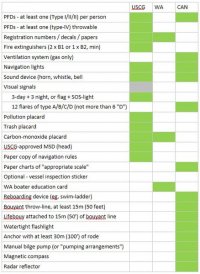Hi,
We live on Vancouver Island and sail the Gulf islands regularly and know them well, so I would be pleased to answer questions for you and for others, if interested. We have 240' of anchor rode and it is sufficient for this area. The various bays are often not very large and so are shallow (20 to 30' depth for anchoring) and the larger ones are often quite busy in the summer time, so there's not enough room for more than about 4:1 scope. In short, I usually use about 120', sometimes 150' if the wind comes up a bit, but very rarely do I use my full 240'. If you are going on to Desolation Sound or further north, some areas are more rugged and deeper even close to shore, so 300' would be useful there, though we have also sailed and anchored there and our 240' was fine.
A stern line is very useful for the smaller bays, where a few boats can anchor in parallel and stern tie; sometimes it's even required (though not in Genoa Bay). I think 300' of stern tie is minimum and would recommend 500'. That allows you the option of taking the stern line ashore and looping it around a tree and then back out to the boat--in the morning you only have to undo the line from the stern cleat and haul it all in without going ashore to untie it there. If that's not important for you, then 300' would be enough. Stern line should be a floating line, visible colour like yellow polypropylene, and strong enough to hold the boat if the wind blows on your beam while you are anchored/stern tied.
The Gulf Islands are beautiful with many lovely anchorages and marinas. If possible, it would make sense to spend an extra week to ten days exploring them (there are several good cruising guides for the area). If that's not possible due to time constraints, I would suggest an overnight stay at the Port of Sidney marina just north of Victoria and Oak Bay. From the marina it's only a few minutes walk into the lovely small town with many book stores, restaurants, art galleries, wine/liquor store; it's also a really good place to provision after crossing the border, and they do have a customs dock if this is your first entry point. As the Gulf Islands are a popular cruising ground for both Canadian and American boaters, they get fairly busy (though still pleasant) in summer; reservations are strongly recommended at most marinas, and anchorages start to fill up in mid-afternoon. However, if you can be flexible on your anchoring location, you can almost always find a spot even after supper.
I would also recommend spending a few hours at Butchart Gardens--an incredibly beautiful garden with many lovely and exotic plants, flowers and trees covering many acres. The night water/light show is stunning. This garden can be accessed from Sidney by shuttle (enquire first to be sure) or better yet, if you anchor near Todd Inlet, you can take a short dinghy row to the dock at the back entrance to the Butchart Gardens (ask me for more details if you want to do this).
Other lovely places to consider include the town of Ganges on Salt Spring island, Wallace Island, Poet's Cove marina, Telegraph harbour marina, Maple Bay marina, Pirates Cove anchorage (caution to enter properly to avoid the reef).
Also, a reminder to anyone coming to the 2018 Rendezvous at Genoa Bay, check your charts and find the correct markers on entering Genoa Bay as there is a large shallow area and reefs on the starboard side/east side of the Bay that is not visible at high tide.
I hope this helps!
Frank


